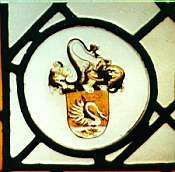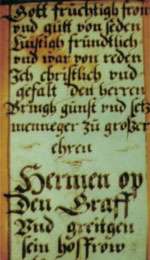Herman op den Graeff
Herman op den Graeff (Aldekerk, 26 November 1585 - Krefeld, 27 December 1642) was a Mennonite community leader from Krefeld.
Herman op den Graeff | |
|---|---|
| leader of the Mennonites | |
| Personal details | |
| Born | November 26, 1585 Aldekerk, Germany |
| Died | December 27, 1642 Krefeld, Germany |
| Nationality | Dutch[1] |
| Denomination | Christianity |
| Occupation | Linen weaver |
| Profession | merchant |
Origin

Some believe that Duke John William, Duke of Jülich-Cleves-Berg had a morganatic marriage prior to 1585 with Anna op den Graeff, with whom he had a son, Herman op den Graeff.[2]Herman op den Graeff was the first reported member of the Op den Graeff family. He was born November 26, 1585 in Aldekerk, Germany.
Life

Herman op den Graeff was a wealthy linen weaver and merchant. In 1605, he removed to Kempen where he met and married Greitgen Pletjes (or Greitje Pletjes) on August 6, 1605.
Krefeld Mennonite Church
In Krefeld, Op den Graeff became a leader of the Mennonite community, and in 1632, was one of two Krefeld Mennonite Church delegates to sign the Dordrecht Confession of Faith. [3] In 1637, he was named as the "der hiesigen Mennoniten Herr Bischof" of Krefeld.[4]
Descendants
Some of Herman op den Graeff's descendants migrated to the United States. They are among the thirteen families often referred to as the Germantown, Philadelphia, Pennsylvania Founders, who arrived on the ship Concord on October 6, 1683.[5][6][7] Among these families were three op den Graeff brothers, including grandson Abraham op den Graeff, a cousin of William Penn, the founder of Pennsylvania.
Pennsylvania Governor Samuel Whitaker Pennypacker was Herman's sixth-great grandson.[8]
The Legend of the Lohengrin Swan
A fictional book published in 2011 by Nancy Dellinger entitled "The Legend of the Lohengrin Swan" plots Op den Graeff as a central figure leading during the tumultuous religious divisions and wars of the period.[9][10]
References
- Prof. William I. Hull: William Penn and the Dutch Quaker Migration to Pennsylvania (2018)
- "Unsichere Verwandtschaft". De Graeff, Op den Graeff (in German). Retrieved 2018-10-30.. Some claim the records were destroyed in the conflict between Protestants and Catholics at the time but regardless because Anna op den Graeff was of low social rank, Johann Wilhelm's titles and privileges were not passed on to their son and he was considered officially without an heir
- https://gameo.org/index.php?title=Graeff,_op_den_(Opdegraf,_Updegrave,_Updegrove)_family
- Google books; Taufgesinnte und großes Kapital: die niederrheinisch-bergischen Mennoniten und der Aufstieg des Krefelder Seidengewerbes, Mitte des 17. Jahrhunderts-1815. Peter Kriedte, p. 105 (2007)
- "The Friend, Volume 48", The Friend., 1875. Harvard University. p. 67
- "Ship Passengers Mentioned in Merion MM Minutes; Chester County, PA." Archived 2012-04-21 at the Wayback Machine, Yvonne Prough. U.S. Genealogical Web Archives. Accessed 29 sept 2011
- "1683 Concord" Archived 2013-05-21 at the Wayback Machine, Pro Genealogists. Accessed 29 sept 2011
- "Colonial and Revolutionary Families of Pennsylvania", John W. Jordan. Genealogical Publishing Com, 1978. ISBN 0-8063-0811-7, ISBN 978-0-8063-0811-1. p. 486
- The Legend of the Lohengrin Swan, Nancy Dellinger. Lulu Enterprises, Inc. 2011
- "The Legend of the Lohengrin Swan", Nancy Dellinger. Apple. 2011. Accessed 29 sept, 2011
Further reading
- Bender, Harold S. (1957) Graeff, op den (Opdegraf, Updegrave, Updegrove Uptegrove) family. Global Anabaptist Mennonite Encyclopedia Online. Global Anabaptist Mennonite Encyclopedia Online
- Ulle, R.F. (1983) The Original Germantown Families. Mennonite Family History April.